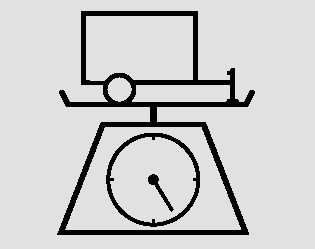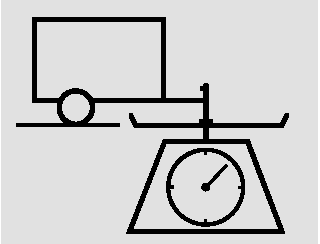Honda Accord: Towing a Trailer
 Honda Accord: Towing a Trailer
Honda Accord: Towing a Trailer
Your vehicle has been designed primarily to carry passengers and their cargo. You can also use it to tow a trailer if you carefully observe the load limits, use the proper equipment, and follow the guidelines in this section.
Break-In Period
Avoid towing a trailer during your vehicle’s first 600 miles (1,000 km).

Exceeding any load limit or improperly loading your vehicle and trailer can cause a crash in which you can be seriously hurt or killed.
Check the loading of your vehicle and trailer carefully before starting to drive.
Load Limits

Total Trailer Weight: The maximum allowable weight of the trailer and everything in or on it must not exceed 1,000 lbs (450 kg).
Towing a load that is too heavy can seriously affect your vehicle’s handling and performance. It can also damage the engine and drivetrain.

Tongue Load: The weight that the tongue of a fully-loaded trailer puts on the hitch should be approximately 10% of the total trailer weight. Too much tongue load reduces front-tire traction and steering control. Too little tongue load can make the trailer unstable and cause it to sway.
To achieve a proper tongue load, start by loading 60% of the load toward the front of the trailer and 40% toward the rear, then re-adjust the load as needed.
- Gross VehicleWeight Rating (GVWR):
- Gross AxleWeight Rating (GAWR):
- Checking Loads
- Towing Equipment and Accessories
- Pre-Tow Checklist
- Driving Safely With a Trailer
- Towing Your Vehicle
Gross VehicleWeight Rating (GVWR):
The maximum allowable weight of the vehicle, all occupants, all accessories, all cargo, and the tongue load is:
U.S. models
LX:
4,299 lbs (1,950 kg)
EX and EX-L:
4,409 lbs (2,000 kg)
V6 models with automatic transmission:
4,541 lbs (2,060 kg)
V6 models with manual transmission:
4,475 lbs (2,030 kg)
Canadian models
LX:
1,970 kg
EX and EX-L:
2,020 kg
V6 models with automatic transmission:
2,075 kg
V6 models with manual transmission:
2,040 kg
Gross AxleWeight Rating (GAWR):
The maximum allowable weight at the vehicle axles is:
U.S. models
LX:
2,337 lbs (1,060 kg)
on the front axle
2,006 lbs (910 kg)
on the rear axle
EX and EX-L:
2,414 lbs (1,095 kg)
on the front axle
2,039 lbs (925 kg)
on the rear axle
V6 models with automatic transmission:
2,535 lbs (1,150 kg)
on the front axle
2,050 lbs (930 kg)
on the rear axle
V6 models with manual transmission:
2,425 lbs (1,100 kg)
on the front axle
2,050 lbs (930 kg)
on the rear axle
Canadian models
LX:
1,065 kg
on the front axle
910 kg
on the rear axle
EX and EX-L:
1,095 kg
on the front axle
930 kg
on the rear axle
V6 models with automatic transmission:
1,160 kg
on the front axle
950 kg
on the rear axle
V6 models with manual transmission:
1,110 kg
on the front axle
950 kg
on the rear axle
Checking Loads
The best way to confirmthat all loads are within limits is to check them at a public scale. For public scales in your area, check your local phone book, or contact your trailer dealer or rental agency for assistance.
If you cannot get to a public scale, you can estimate the total trailer weight by adding the weight of your trailer (as quoted by the manufacturer) with everything in or on the trailer.
If you normally pull the same load each time you tow a trailer, you can use a suitable scale or a special tongue load gauge to check the tongue load the first time you set up a towing combination (a fully loaded vehicle and trailer), then recheck the tongue load whenever the conditions change.
Towing Equipment and Accessories
Towing can require a variety of equipment, depending on the size of your trailer, how it will be used, how much load you are towing, and where you tow.
Discuss your needs with your trailer sales or rental agency, and follow the guidelines in this section. Also make sure that all equipment is properly installed and maintained, and that it meets federal, state, province, territory, and local regulations.
Hitches
Any hitch used on your vehicle must be properly bolted to the underbody.
Safety Chains
Always use safety chains when you tow a trailer.Make sure the chains are secured to the trailer and hitch, and that they cross under the tongue and can catch the trailer if it becomes unhitched. Leave enough slack to allow the trailer to turn corners easily, but do not let the chains drag on the ground.
Trailer Brakes
There are two common types of trailer brakes: surge and electric.
Surge brakes are common for boat trailers, since the brakes will get wet.
If you choose electric brakes, be sure they are electronically actuated.
Do not attempt to tap into your vehicle’s hydraulic system. No matter how successful it may seem, any attempt to attach trailer brakes to your vehicle’s hydraulic system will lower braking effectiveness and create a potential hazard.
See your trailer dealer or rental agency for more information on installing electric brakes.
Trailer Lights
Trailer lights and equipment must comply with federal, state, province, territory, and local regulations.
Check with your local trailer sales or rental agencies for the requirements in the area where you plan to tow, and use only equipment designed for your vehicle.
Since lighting and wiring vary by trailer type and brand, you should have a qualified technician install a suitable connector between the vehicle and the trailer. Improper equipment or installation can cause damage to your vehicle’s electrical system and affect your vehicle warranty.
Additional Towing Equipment
Many states and Canadian provinces/territories require special outside mirrors when towing a trailer.
Even if they don’t, you should install special mirrors if you cannot clearly see behind you, or if the trailer creates a blind spot.
Ask your trailer sales or rental agency if any other items are recommended or required for your towing situation.
Pre-Tow Checklist
When preparing to tow, and before driving away, be sure to check the following:
The vehicle has been properly serviced, and the suspension and the cooling system are in good operating condition.
The trailer has been properly serviced and is in good condition.
All weights and loads are within limits.
The hitch, safety chains, and any other attachments are secure.
All items in or on the trailer are properly secured and cannot shift while you drive.
The lights and brakes on your vehicle and the trailer are working properly.
Your vehicle tires and spare are properly inflated, and the trailer tires and spare are inflated as recommended by the trailer maker.
Driving Safely With a Trailer
The added weight, length, and height of a trailer will affect your vehicle’s handling and performance, so driving with a trailer requires some special driving skills and techniques.
For your safety and the safety of others, take time to practice driving maneuvers before heading for the open road, and follow the guidelines in this section.
Towing Speeds and Gears
Drive slower than normal in all driving situations, and obey posted speed limits for vehicles with trailers.
Do not exceed the limited speed when towing a trailer. At higher speeds, the trailer may sway or affect vehicle handling (see ‘‘Driving on Hills’’ in the next page for additional gear information).
If your vehicle has an automatic transmission, use the D position when towing a trailer on level roads.
4-cylinder models with automatic transmission
D3 is the proper shift lever position to use when towing a trailer in hilly terrain.
V6 models with automatic transmission
When driving uphill and downhill, use the S position (without using the paddle shifters) to provide the proper engine power and engine braking on each gear. You can also use the paddle shifters. In this case, select third, second, or first gear with the paddle shifter; depending on the vehicle speeds and road condition. Do not use fourth and fifth gears.
If the automatic transmission fluid temperature increases and exceeds the specified limit, the transmission will also automatically downshift to the first gear even with the Sequential Sportshift Mode. This prevents the automatic transmission from overheating. In this case, the gear position ‘‘1’’ next to the ‘‘M’’ indicator in the instrument panel blinks for about five seconds, then it stays on.
Making Turns and Braking
Make turns more slowly andwider than normal. The trailer tracks a smaller arc than your vehicle, and it can hit or run over something the vehicle misses. Allow more time and distance for braking. Do not brake or turn suddenly as this could cause the trailer to jackknife or turn over.
Driving on Hills
When climbing hills, closely watch your temperature gauge. If it nears the red (Hot) mark, turn the air conditioning off, reduce speed and, if necessary, pull to the side of the road to let the engine cool.
When driving down hills, reduce your speed and always apply engine braking by shifting down. If your vehicle has a manual transmission, when going down a steep hill, use the second gear to provide greater engine braking.
4-cylinder models with automatic transmission
If the automatic transmission shifts frequently while going up a hill, shift to D3.
When driving down hills, reduce your speed and shift down to the second gear.
V6 models with automatic transmission
When driving down hills, reduce your speed and use the S mode. You can also use the paddle shifters to change the gear position. Select third, second or first gear depending on the vehicle speeds and road condition. When going down a steep hill, use second gear to provide greater engine braking. Shift down to first gear when driving up steep hills.
Do not ‘‘ride’’ the brakes, and remember, it will take longer to slow down and stop when towing a trailer.
If you must stop when facing uphill, use the foot brake or parking brake.
Do not try to hold the vehicle in place by pressing on the accelerator, as this can cause the automatic transmission to overheat.
Handling Crosswinds and Buffeting
Crosswinds and air turbulence caused by passing trucks can disrupt your steering and cause the trailer to sway. When being passed by a large vehicle, keep a constant speed, and steer straight ahead. Do not try to make quick steering or braking corrections.
Backing Up
Always drive slowly and have someone guide you when backing up.
Grip the of the steering wheel, then turn the wheel to the left to get the trailer to move to the left, and turn the wheel right to move the trailer to the right.
bottom
Parking
Follow all normal precautions when parking, including firmly setting the parking brake and putting the transmission in Park (automatic) or in first or reverse (manual). Also, place wheel chocks at each of the trailer’s tires.
Towing Your Vehicle
Your vehicle is not designed to be towed behind a motor home. If your vehicle needs to be towed in an emergency.


